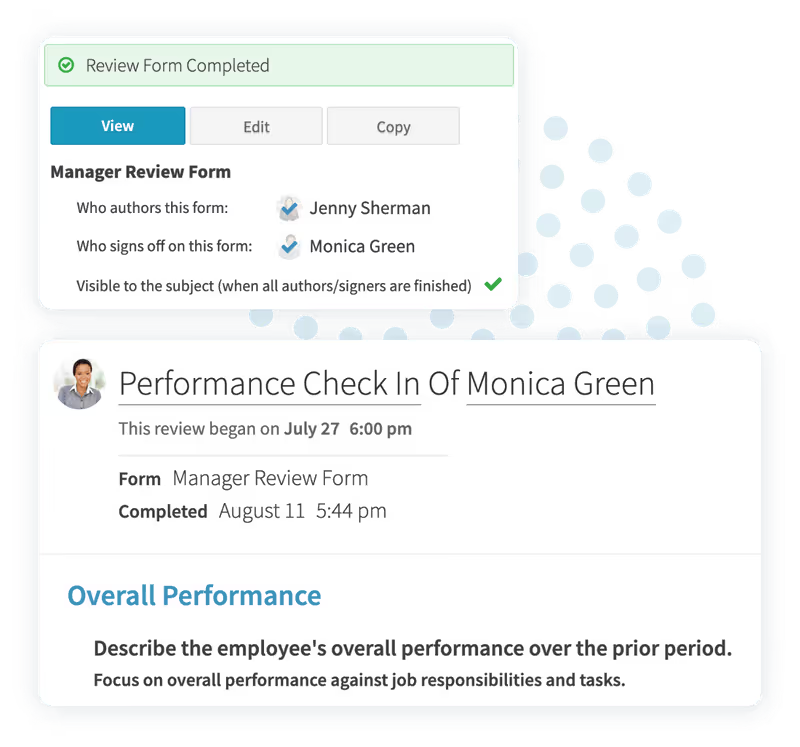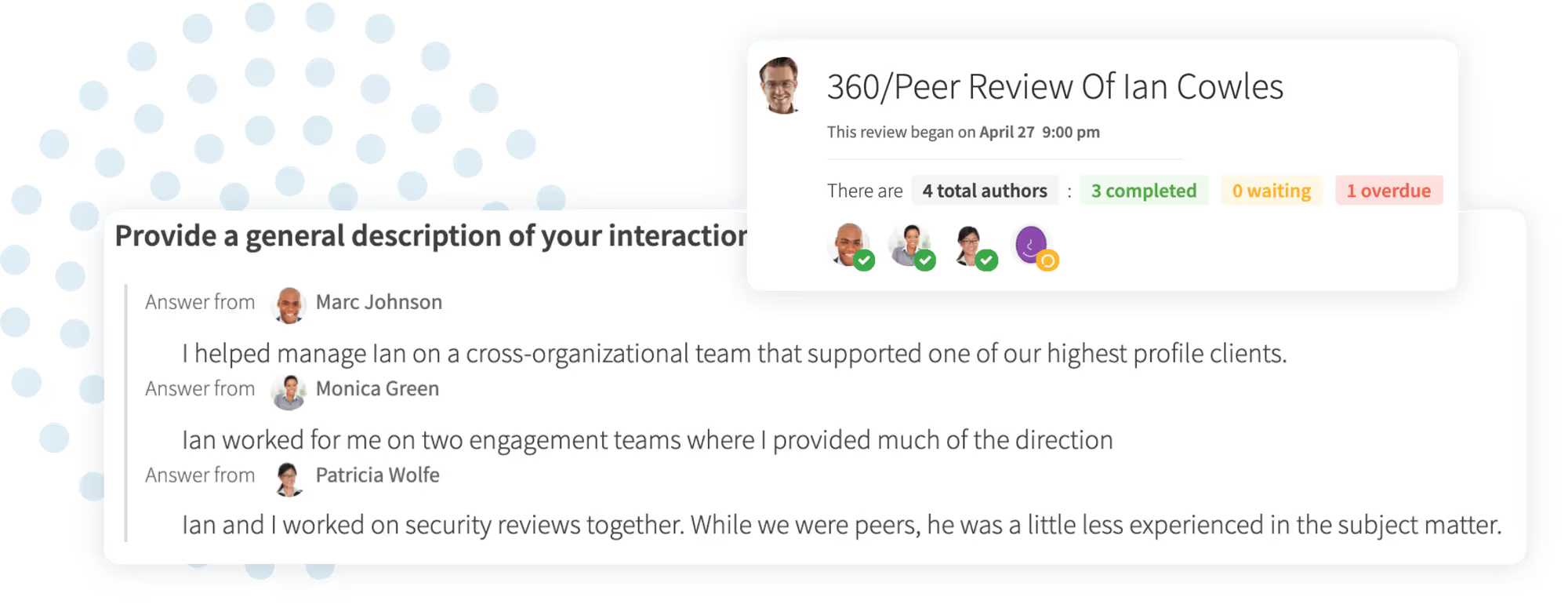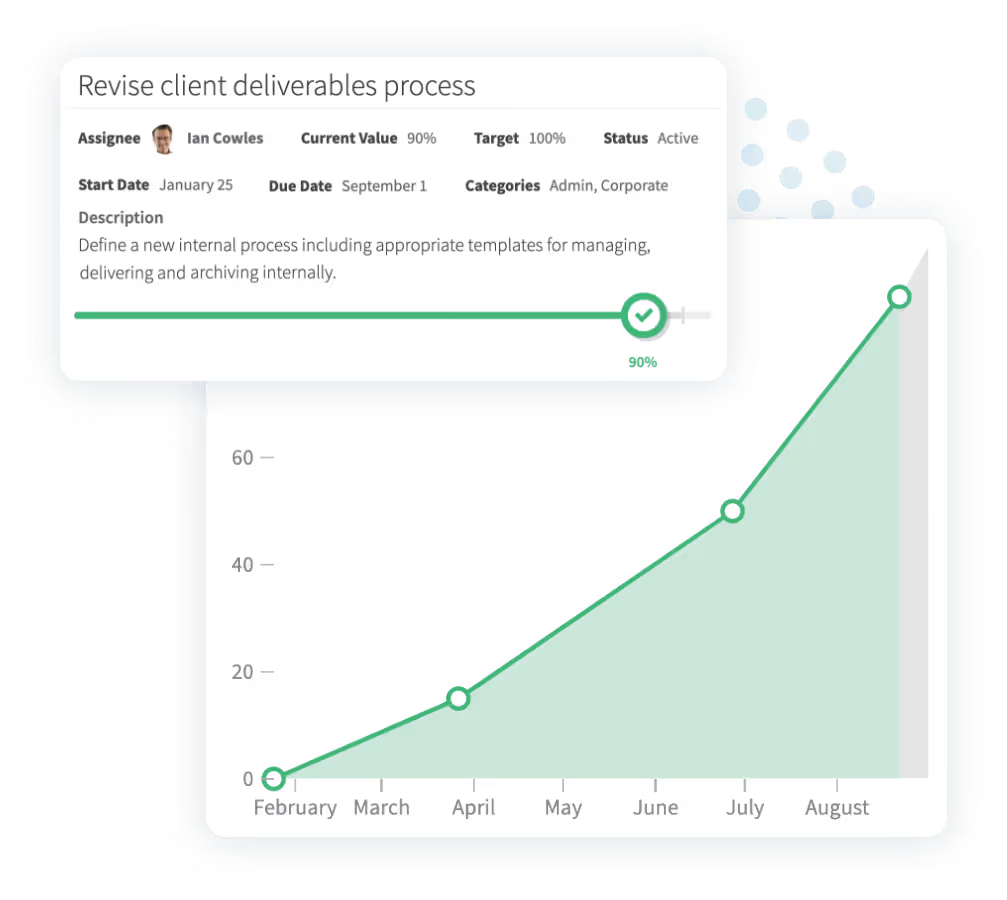The HR Guide to Software Engineer Performance Reviews
Software engineers are the behind-the-scenes rock stars of our technology-driven world. From computer systems to app development, they are essential members of any team in the 21st century. Without them, other employees may not be able to do their jobs and essential services can crash, tanking your bottom line right along with them.
But, filling software engineer positions can be hard. In 2020, 69% of U.S. employers had difficulty filling in-demand positions like software engineers. With employment for software engineers expected to grow by 22% from 2020 to 2030, it’s going to continue to be a difficult role to fill.
It’s more important than ever to support your software engineer employees. That includes supporting their professional development so they aren’t tempted to jump ship. Your number one goal should be to avoid having to go through the struggle of trying to fill their vacant position.
One way to do that is to create a meaningful engineering performance review process. The question is how?
Here is everything you need to know about performance reviews for engineers. The article includes software engineer performance review examples and metrics. Read on to learn how to provide the professional development, support, and praise that makes engineers want to stick around.
Which Touchpoints to Use for Software Engineer Reviews
There isn’t a one-size-fits-all approach to a software engineer review. The following touchpoints are options you can choose from that work best for you and your team. Choose one or two to get started, but don’t be afraid to revisit these ideas and change your review process if the needs of your team change.
- 1:1s
- 360 Peer review
- Project-based review
- Team review
- Annual review
1:1s
When you think of an engineer performance review, you envision a yearly formal review (which we’ll get to in a minute). It is an option, but your employees are likely to feel frustrated if they only get to talk about their goals and accomplishments once a year.
That’s where 1:1s come in.
They serve as extra touchpoints between formal reviews. Team members can share feedback with engineering managers and update management on current projects. It’s a great opportunity to reevaluate a goal that isn’t working, as well as gather the information that can be used during a more formal review. They can also support the process of building strong interpersonal relationships in the office.
This software engineer performance review example can be formal or informal. Either way, check-ins are an easy way to conduct 1:1s without extensive planning.

360 Peer review
Software engineers may indeed spend quite a bit of time alone focusing on their work and doing code reviews, but they are still part of a larger team. Whether they are interacting in person or through messenger systems, it’s a good idea to assess how coworkers feel about each other.
After all, how employees work together can have a huge impact on productivity, company culture, and turnover. Satisfaction increases by 50% when employees have at least one close relationship at work. If dealing with negativity, office politics, or disrespectful behavior, 58% have left or would consider leaving a job.
One of our favorite software engineer peer performance review examples is the 360-degree feedback review. This review enables you to collect performance assessment data based on what other employees see and experience. The review gives management context for feedback. You’ll be able to dig deeper into why a certain project had delays or why a project went well. Managers can compare how each software engineer fits into the culture of your organization. The team can work on team building conflict resolution before an issue becomes a huge problem.

Project-based review
Project-based reviews are a great choice for software engineers. Every development project presents unique challenges. Beyond assessing technical skills based on quality or code readability, a project-based review lets you provide constructive feedback on the engineer's performance as part of a team.
These reviews enable you to talk about the specifics of each project. You can can conduct goal-setting for the next project without getting sidetracked by more generalized performance data.
The biggest challenge with this type of review is the fact that projects don’t always finish at the same time. You can’t pencil in a certain time of year to conduct software engineer performance reviews. You’ll have to use flexible performance management software to activate the review cycle when a project nears completion.
Then, you have to make sure to ensure everyone has the time to join in the process without jumping headfirst into the next project.
Team review
Because so many software engineering tasks are project-based, a team review can also be a great option. It can give you a great understanding of how the team is doing without zeroing in on each team member. Zeroing in on team members can take a while if you have a large team working on the same project.
If you find that the team isn’t working well, it can be hard to figure out who is contributing to the problem. It could also be the case that a team is only performing well because one engineer is doing all the work. That can cause trouble for management, but it can be frustrating for employees as well.
Some companies have close-knit teams that work together to solve potential problems. Other companies need to bake features of 360 reviews into the process to uncover issues.
Annual review
Well, they don’t work if you do them the old-fashioned way, which means collecting data and meeting with employees once a year. That’s especially the case with software engineers who work on several projects ahead of every annual review. It’s impossible to capture all the feedback for those projects at a single meeting.
That doesn’t mean that you can’t use annual reviews at all! It just means you have to change how you approach the annual review process.
An annual review should be the culmination of other review touchpoints throughout the year. This is true if you’re conducting any of the software engineer performance review examples mentioned above. This approach prevents employees from feeling surprised at their review meeting. You should already be meeting throughout the year to discuss performance and goals. That way, employees will have a good idea of what to expect at their annual review.
Criteria to Use in Software Engineer Performance Reviews
So you’ve decided what kind of review touch points to use. That’s great! It doesn't mean you know what kind of information should be in those reviews.
Here are the software engineer performance review metrics to use in your review process:
- Professional development
- Ability to be proactive
- Communication
- Product usability
- Leadership
Professional development
Without a doubt, professional development should be part of every review.
Employees who have access to professional development opportunities are 15% more engaged on the job. According to one survey, 94% of respondents said they would stay at a company longer if that company invested in their careers.
When it comes to engineers, it’s even more important for them to pick up new skills, certifications, and coding languages. Not doing so means falling behind in the fast-moving technology industry.
Discuss each employee’s personal and professional development goals. Get crystal clear on the goals you have for your software engineers and the teams they work on. This will let you include measurable, professional development goals in the review process.
Ability to be proactive
Are software engineers fixing bugs before they become an issue? Are they developing new features and coming up with new ideas unprompted? These types of questions get to the heart of whether a software engineer is being proactive on the job.
The ability to be proactive is an important thing to foster among employees. Proactive employees tend to be better performers, contributors, and innovators. Not to mention, they can save management time while driving the company's organizational goals forward.
Measuring the ability to be proactive can be difficult because it is a qualitative measure and not a quantitative one. You can use peer reviews, continuous feedback, and 1:1s as measuring tools. Software like PerformYard lets you to capture and store feedback throughout the year. It can collate and analyze the information exactly when you need it.
Communication
Measuring how your team communicates with each other is an essential aspect of conducting a team review, but it can be helpful in other cases as well. Measuring communication can increase efficiency and foster positive interpersonal relationships.
To measure this metric, you have to build a culture of feedback. That means making it easy for employees to provide feedback when it’s convenient for them. PerformYard provides you with a central place for everyone to store their feedback between reviews. When review time does roll around, you can access accurate, specific feedback that came in the moment. You won’t have to ask employees to come up with communication feedback on an old interaction.
Product usability
What is the quality of the product that your software engineers are creating? Do platforms contain bugs, or do they work well? Do users give it good reviews?
Answering these types of questions helps you determine how much value engineers bring to the company. To track them, you will need to set clear goals with your software engineers that are related to these types of metrics. That might mean shooting for a certain number of positive reviews or completing a project with fewer bugs than the last project.
PerformYard lets you pull up the data when completing review forms and discuss it without bias.
Leadership
Uncovering leadership capabilities shouldn’t wait until an annual review. You should measure it throughout the year. It's the best way for you to support leadership development, pivot if necessary, and provide accolades.
Like proactivity and communication skills, leadership can be difficult to measure. Peer reviews are one way to gather information about leadership as it impacts other members of a team. You can also view project-based reviews and team reviews to see if one employee stepped up to meet a deadline or encouraged the team to find a solution.
Having a place to store this information as it comes up is important. Your employees can capture feedback throughout the year rather than trying to gather information at review time.
Common Mistakes in Software Engineer Performance Reviews
Knowing what not to do is as important as knowing what to do when it comes to software engineer performance reviews. A few common pitfalls you’ll want to avoid include:
- Using too many hard metrics
- Failing to highlight individual achievements
- Providing them with a cumbersome review process
- Waiting too long to provide feedback
Using too many hard metrics
Number-based metrics are the easiest to measure, so they are often relied on in an engineer or software developer performance review. That said, information can fall through the cracks if you’re only using quantitative analysis.
You can’t measure leadership, communication, or proactivity with numbers. Measuring employee performance based on the number of bug fixes or lines of code written could leave you thinking you have a high-performing employee when you don’t.
It’s much better to have a balance of hard and soft metrics so you can gain a clearer picture of employee performance.
Failing to highlight individual achievements
It’s easy to get caught up in day-to-day tasks that leave little time for acknowledging individual achievements, but that’s a mistake. Effective software engineers who are properly recognized for their contributions are five times more likely to see a path to professional growth in the company they work for and they are four times more likely to be engaged at work. They are also less likely to leave their position or report feelings of overwhelming burnout.

Using performance management software to conduct multiple reviews throughout the year allows you to recognize individual achievements. With a well-designed review process, you can tie promotions and raises to performance. You’ll make employees feel like they are truly appreciated. You can protect your company from having its engineers poached by other companies. Employees are also more likely to be engaged in providing—and finding—value in their role.
Providing them with a cumbersome review process
Performance reviews are valuable, but they can also be irritating. The more they interfere with everyone’s ability to get their work done, the less likely they are to get real value from the process. It’s also less likely that you’ll get accurate, helpful information, which means the entire review cycle is a waste.
Software engineers and their managers are busy. Don’t make it difficult for them to track their goals, complete review forms, or demand that they provide impromptu feedback. Don’t slow the process down by using spreadsheets and Google Docs.
Take the time to design a review process that works for you, your employees, and the company using dedicated performance management software. It’s designed to make reviews as easy, valuable, and accurate as possible so the process doesn’t feel like it encroaches on day-to-day operations.
Waiting too long to provide feedback
Over 75 percent of the respondents in one survey agreed that receiving feedback on the job is important. That said, don’t pat yourself on the back yet if you think you’re providing good feedback at an annual software engineer performance review. It’s also important to provide that feedback in a timely manner.
Nearly 60 percent of workers said they would like to have feedback on a daily or weekly basis.
Providing feedback that frequently may sound like a lot of work. It’s worthwhile. Waiting too long to provide feedback to a software engineer who craves it encourages them to start looking for another job. Plus, they’re likely to find one. Software engineers are in high demand.
Talk with your engineering team and come up with a feedback schedule that works for everyone. Then, create and execute a plan that ensures everyone receives that feedback promptly.

